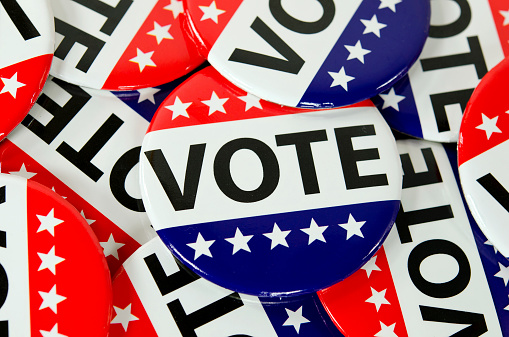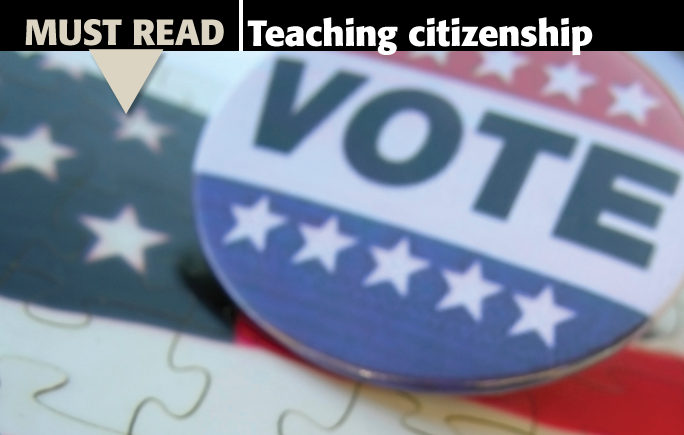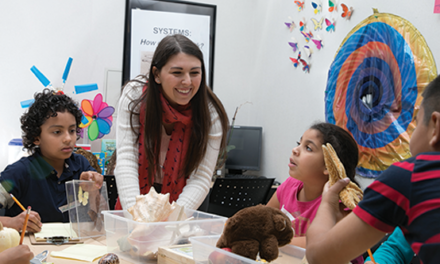
Even during election season, we can be sure that most American students won’t spend significant time in school studying the issues, learning about the candidates, and developing expertise in the political process. To the extent that educators teach any lessons about contemporary politics, they’ll focus on federal elections — especially the presidential race — even though most of the decisions that will affect students and their families will be made by local and state officials and, to a lesser extent, by Congress, not by President Obama, President Romney, President Santorum, or President Trump. Even among students who master the issues and develop opinions about candidates’ platforms or ballot initiatives, only a small number will be encouraged, let alone required, by their schools to take action during the campaign season — volunteer for a candidate, participate in a get-out-the-vote effort, or express their opinion in a public forum. Students in urban schools are least likely to have these opportunities.
There is compelling evidence that many students, especially low-income students of color, are getting little if any civic education. We have a profound civic empowerment gap — as large and as disturbing as the reading and math achievement gaps — between low-income citizens of color, on the one hand, and middle-class and wealthy white citizens, on the other. African-American, Hispanic, and poor students perform significantly worse on standardized tests and surveys of civic knowledge and skills than white, Asian, and middle-class students. This is problematic because civic knowledge is directly correlated with higher levels of political participation and expressions of democratic values. Individuals’ mastery of civic skills is also tied to both their likelihood of civic participation and especially their effectiveness. It’s hard to measure students’ civic and political participation rates, but we definitely see disparate participation patterns among adults. Two-thirds of white and black voting-age citizens voted in the 2008 presidential election, for example, while barely half of Hispanic or Asian citizens did so. Since about one-third of Hispanic and Asian residents are noncitizens and hence ineligible to vote, these low voting rates among those who are citizens further depress Hispanic and Asian-American’s already relatively weak political voice at a national level. Similarly, citizens without a high school diploma were only half as likely to have voted as citizens with a bachelor’s or advanced degree. These disparities aren’t limited to voting or even to politics. Broader measures of civic participation — belonging to any group or organization, working on a community problem, volunteering, attending a community meeting, or just wearing a campaign button or putting a political bumper sticker on one’s car — are also highly unequally distributed by educational attainment and ethnoracial group.
The civic empowerment gap is no more natural or inevitable than the academic achievement gap. Thankfully, most Americans are no longer willing to accept as natural the fact that the average black 12th grader reads at the same level as the average white 8th grader. Any school that countenances academic failure or mediocrity among its poor students of color is rightly condemned as failing its most fundamental educational mission. Moreover, our failure to educate poor children of color is viewed as a blot upon the nation as a whole. Virtually all Americans accept (in theory, at least) that we have a national responsibility to provide adequate academic education to all children, and we claim (in theory, at least) that all children can achieve academically. We must reach the same conclusions about our nation’s and, hence, every school’s obligation to help all children achieve civic empowerment. American public schools were founded for civic purposes. We must hold schools to account — and hold ourselves to account — for achieving civic outcomes for all children that are as high quality as the academic outcomes we now claim to expect.
How did this happen?
In the 1960s, political scientists concluded that school-based civic education had no effect on students’ civic learning. We now know that this judgment is wrong. There is incontrovertible evidence that schools can increase students’ civic knowledge, engagement, and identity through open classroom discussions and debates, simulations and other forms of experiential civic education, student participation in school governance, current events lessons, media literacy curricula, and policy-oriented service learning. Students also learn democratic skills and habits in response to school context. Schools can create intentional civic spaces that teach students how to interact respectfully and productively with students different from themselves, since this learning doesn’t occur on its own. Students who feel respected — as if teachers take their ideas and perspectives seriously — are also much more likely to express democratic identity and values. These findings confirm that schools have an essential role to play in ensuring that all Americans develop the capacities and inclination for effective, thoughtful, public-spirited civic engagement.
Civic education also is excluded from standards-based curricula because current events and engaged civic action cannot be standardized and specified in advance. Good civic education is demonstrably contextual, particular, and dynamic. For young people to participate effectively in democratic civic and political life, in other words, they must master at least some time-, location-, and context-specific knowledge and skills. Some months, elections dominate the news; at other times, the economy, foreign affairs, or a local scandal dominates the agenda. Towns may be governed by a strong mayor, a weak mayor in collaboration with the city council, a city manager, or some other structure. The schools, public housing authority, and parks departments may be subject to mayoral control, controlled by the county or state, or function as independent agencies with elected governing boards. These differences matter in teaching students how to exercise civic and political power effectively. Whether they want to advocate for more youth summer employment opportunities or for a skateboarding area in their new park, students must know whom to work with and how; this will differ over time and from place to place.
Other good civic education practices also demand significant contextual flexibility and variation. How a school constructs and maintains a “pro-civic” culture will vary depending on the educational and civic context. A small school with a relatively homogeneous and stable student population will inevitably and appropriately build a different kind of pro-civic school culture than a large school with a highly transitory and diverse population. Schools in neighborhoods plagued by gang violence and ethnic tensions may work to create a civic school culture that emphasizes safety, mutual respect, and a willingness to identify shared goals across lines of apparent difference. A school in a highly stable and even insular neighborhood, by contrast, may strive to create a civic culture that provokes respectful disagreement and dislodges students from their conformist complacency. Similarly, sensitivity to community context and even individual student variation applies to educators’ roles in helping students construct empowering civic narratives that are consistent with their experiences and cultures.
By contrast, current curricula and assessment systems are standardized, common, and static. Unfortunately, such common standards, by rigidly specifying the content and skills students must learn and assessing their mastery accordingly, will in principle and in practice work against the development of a dynamic and broad civic education. I am reminded of this frequently when I teach social studies methods to preservice teachers at Harvard. One spring, for example, one student wrote a two-week unit on voting for the 8th-grade Civics in Action course she was student teaching. Even though she was teaching voting in February 2008 during the most exciting presidential primary race in a generation and overlapping with Massachusetts’ participation in Super Tuesday primaries, it didn’t initially occur to her to include anything about the current election. Nor did it occur to her mentor teacher. After all, she was following the standards — and the standards, of course, didn’t include the Obama-Clinton primary face-off or even Super Tuesday!
Many educators and policy makers neglect civic learning because they believe it distracts from the “real work” of schools: namely, teaching literacy and mathematics and eliminating the achievement gap in these areas. Educational equity is undeniably a grave concern, as equality of educational opportunity is both a civil and moral obligation in any democracy. But this insight actually reinforces the need for civic education. Democracies demand equality of opportunity not solely because they value citizens’ equal access to college and career, but because democracies are based on the premise of civic equality. This premise is represented in such democratic principles as “One person, one vote,” and “All are equal before the law.” We betray democracy when some individuals or groups systematically find themselves excluded from the halls of power while others easily slip inside. We undermine democratic legitimacy when some seem to stand above the law while others are subjected to its full, sometimes even brutal, force. Furthermore, democracy itself is weakened when some citizens are silenced. Part of the beauty of democracy, when it functions effectively and inclusively, is its ability to create aggregate wisdom and good judgment from individual citizens’ necessarily limited knowledge, skills, and viewpoints. Excluding citizens from this process diminishes the wisdom that the broader, more inclusive group may create. Democratic nations like the United States must therefore educate for college, career, and citizenship. Civic readiness is the essential “third C” in a democracy. This isn’t a distraction from the “real work” of schools and educational policy makers; it is a crucial part of that work in all schools, in all settings.
What should be done?
We must restore civic education to the curriculum. In the 1960s, students regularly took as many as three civics courses in high school, including civics, democracy, and government; now, students tend to take only one — government — and that often is only in 12th grade, by which point many poor and minority students have already dropped out. Offering civic education only to high school seniors largely restricts it to wealthier and whiter students. Furthermore, offering civic education only a few times during a child’s education and believing that will reliably enable and encourage any student to become an active, engaged citizen is absurd. There is a reason that we require students to take English and math every semester of every year of elementary and secondary school: Mastery takes time and practice. Hence, we expect students to engage in ongoing, consistently reinforced learning and coaching with regard to these essential disciplines and practices. If we want students to become masterful citizens, then the same expectations should apply. Civic education must begin in elementary schools and be a regular part of education K-12 (and beyond).
Old-school “civics,” however, isn’t the answer. The knowledge, skills, attitudes, actions, and pedagogies called for — in other words, for which there is robust evidence of their effectiveness in preparing young people to be active, informed participants in democratic life — are far removed from the dusty flowcharts, lists, and lectures about the structures and functions of government institutions that often pass for “civics.” Part of the problem is that many students at the “bottom” of the civic empowerment gap think government doesn’t work, not for them or anyone they know, and they may well be justified in this belief. They will reject as irrelevant and worse civics classes that emphasize the mechanisms of a functional and essentially fair and democratic system.. Also, even more privileged students tend to be turned off from civics classes that teach about government institutions without teaching how citizens can deploy power in democracies, collaborate to solve public problems, or express themselves about public issues. Young people have lots of energy, enthusiasm, and ambition. Many would love to tackle problems in their schools, their communities, across the nation, or across the world. In doing so, they could make authentic civic contributions that influence or even transform individuals’ and communities’ lives for years to come. This is an incredible opportunity for all concerned.
A new approach to civic learning, therefore, will be much more hands-on, more engaged with contemporary life, more active. One exciting example of this approach is “action civics,” which leads students to learn civics by behaving as actively engaged citizens in a cycle of research, action, and reflection about problems they care about personally while learning about deeper principles of effective civic and especially political action. The National Action Civics Collaborative provides resources to promote this approach both within and beyond schools, including in schools serving predominantly low-income students of color. Member organizations include Mikva Challenge, Youth on Board, Public Achievement, Earth Force, Generation Citizen, and the University Community Collaborative of Philadelphia at Temple University. In each case, they help guide young people through the process of taking informed and empowered action on behalf of issues youth care about, with an eye to helping them master knowledge, skills, beliefs, and habits of civic action that they can apply in the future as well. The organizations differ somewhat in their focus and approach: Earth Force focuses on environmental justice issues, for example, and works in communities around the United States and abroad; Mikva Challenge focuses its work in Chicago by providing curriculum materials, support for school youth councils, electoral activism, and policy-making programs to high school students. But they also share some very similar “best practices.”
All employ virtually the same six stages of civic action, moving from community assessment, issue identification, and research, through power analysis, strategic development, and finally policy-oriented action. These steps are intended to encourage students to take ownership of a civic challenge that they care about, support their acquisition of the knowledge and skills needed to take meaningful action, enable them to take that action — to learn through citizenship and not just about citizenship — and then challenge students to reflect upon the experience as a means of consolidating their learning and empowering them to take effective action in the future. These organizations and others like them also take a purposefully political or policy-oriented stance. They discourage short-term ameliorative approaches — one-shot park cleanups or other forms of short-term volunteerism — in favor of longer-term, institutionalized reforms via engagement with public policy, coalition building, public awareness raising, political engagement, and other change-oriented work. Furthermore, these organizations and the civic engagement they foster build on students’ strengths. Students are positioned as knowledgeable insiders whose insights enable them to make a positive contribution as effective and powerful agents of change. This approach stands in stark contrast — especially for low-income youth of color — to their traditional positioning as bundles of deficits and needs who traumatize the community via academic failure, idleness, and even criminal delinquency.
The best organizations and individual educators who take this action civics approach help students make sense of their experiences — in this case, both their daily lived experiences and their experiences of guided civic engagement — within a critical frame. They challenge students to take on a social justice orientation in reflecting upon their experiences and actions they propose to take. They teach digital media literacy, power analysis, feminist perspectives, and similar critical stances to help young people rethink what is “normal” or acceptable about both the lives they lead and the changes they desire. Action civics-inspired educators are not content to let students’ unexamined assumptions structure and limit students’ analyses of the problems they face or of the range of solutions they consider. By changing how youth understand the world in which they live, therefore, these programs empower young people not only with respect to the particular problem they are concerned about, but more broadly with respect to rethinking social and political possibilities as a whole. In doing so, they empower students to change the world itself.
Adapted from No Citizen Left Behind by Meira Levinson (Harvard University Press, 2012). Copyright © 2012 by the President and Fellows of Harvard College. Used by permission. All rights reserved.
R&D appears in each issue of Kappan with the assistance of the Deans Alliance, which is composed of the deans of the education schools/colleges at the following universities: Harvard University, Michigan State University, Northwestern University, Stanford University, Teachers College Columbia University, University of California, Berkeley, University of California, Los Angeles, University of Michigan, University of Pennsylvania, and University of Wisconsin.
Originally published in April 2012 Phi Delta Kappan 93 (7), 66-69. © 2017 Phi Delta Kappa International. All rights reserved.
ABOUT THE AUTHOR

Meira Levinson
MEIRA LEVINSON is an associate professor of education in the Harvard Graduate School of Education, Cambridge, Mass. She is author of No Citizen Left Behind and coeditor of Making Civics Count .










